Temporal and Spatial Distribution Characteristics of Crosstalk Lines Generated by Irradiating Progressive Scan Charge-Coupled Device Camera with Continuous Laser
Abstract
:1. Introduction
2. Experimental Setup
3. Results and Discussion
3.1. CCD Irradiating by Continuous Laser in Static Mode
3.1.1. Effect of Laser Fluence
3.1.2. Effect of Delay Time
3.2. CCD Irradiating by Continuous Laser in Motion Mode
3.2.1. Effect of Rotation Speed
3.2.2. Effect of Positions Scanned by Moving Laser
4. Conclusions
Author Contributions
Funding
Institutional Review Board Statement
Informed Consent Statement
Data Availability Statement
Conflicts of Interest
References
- Ramazanov, A.; Simon, V.; Uhov, A.; Kostrin, D.; Gerasimov, V.; Selivanov, L. Modification of the CCD Photodetectors for the Suppression of Interference in Their Internal Structure. In Proceedings of the International Conference PhysicA.SPb/2017, Saint-Petersburg, Russia, 24–26 October 2017; Journal of Physics: Conference Series. IOP Publishing Ltd.: Bristol, UK, 2017; Volume 1038, p. 012098. [Google Scholar]
- Towaranonte, B.; Gao, Y. Application of Charge-Coupled Device (CCD) Cameras in Electrochemiluminescence: A Minireview. Anal. Lett. 2022, 55, 186–202. [Google Scholar] [CrossRef]
- Baranov, M. Image Processing of Biological Liquids Films for Medical Diagnostics. J. Electron. Sci. Technol. 2020, 18, 100027. [Google Scholar] [CrossRef]
- Choi, E.; Choi, S.; An, K.; Kang, K. Deep Learning-Based Inkjet Droplet Detection for Jetting Characterizations and Multijet Synchronization. ACS Appl. Mater. Interfaces 2024, 16, 18040–18051. [Google Scholar] [CrossRef]
- Oh, S.; Kang, H. Object Detection and Classification by Decision-Level Fusion for Intelligent Vehicle Systems. Sensors 2017, 17, 207. [Google Scholar] [CrossRef]
- Li, Y.; Kou, Z.; Wang, G.; Hou, Y.; Xie, X.; Yu, Y.; Wang, Y.; Lu, Z. Recent Advances of Short-Pulse Laser–Induced Breakdown Effect on Charge-Coupled Device Detectors. Opt. Laser Technol. 2022, 156, 108533. [Google Scholar] [CrossRef]
- Li, G.; Shen, H.; Li, L.; Zhang, C.; Mao, S.; Wang, Y. Laser-Induced Damages to Charge Coupled Device Detector Using a High-Repetition-Rate and High-Peak-Power Laser. Opt. Laser Technol. 2013, 47, 221–227. [Google Scholar]
- Gopinath, D.; Soman, M.; Holland, A.; Keelan, J.; Hall, D.; Holland, K.; Colebrook, D. Soft X-ray Radiation Damage in EM-CCDs Used for Resonant Inelastic X-ray Scattering. J. Instrum. 2018, 13, C02027. [Google Scholar] [CrossRef]
- He, B.; Yao, Z.; Zhang, F. A Comparison of Ionizing Radiation Damage in CMOS Devices from 60Co Gamma Rays, Electrons and Protons. Chin. Phys. C 2009, 33, 436. [Google Scholar]
- Zhang, Z.; Cheng, X.; Jiang, T.; Jiang, Z. A Dazzling Phenomenon of CW Laser on Linear CCD Camera. Optik 2012, 123, 223–227. [Google Scholar] [CrossRef]
- Kou, Z.; Li, Y.; Wang, G.; Li, K.; Hou, Y.; Xie, X.; Yu, Y.; Wang, Y.; Lu, Z. Temporal Evolution Characteristics and Mechanism Analysis of CCD Breakdown Induced by Nanosecond and Picosecond Pulse Lasers. Optik 2022, 262, 169313. [Google Scholar] [CrossRef]
- Zhang, Z.; Shi, Y.; Li, Y.; Dou, P.; Xu, Z.; Zhang, J. Performance Jump Characteristics of CCD Image Sensor under Laser Irradiation. In Proceedings of the Fifth International Symposium on Laser Interaction with Matter, Changsha, China, 11–13 November 2018; Volume 11046, p. 110462R. [Google Scholar]
- Zhang, Z.; Cheng, X.; Wang, R.; Jiang, T.; Qiu, D.; Jiang, Z. Dazzling Effect of Repetitive Short Pulse Laser on TDI CCD Camera. Opt. Lasers Eng. 2011, 49, 292–296. [Google Scholar] [CrossRef]
- Sun, K.; Huang, L.; Cheng, X.; Jiang, H. Analysis and Simulation of the Phenomenon of Secondary Spots of the TDI CCD Camera Irradiated by CW Laser. Opt. Express 2011, 19, 23901–23907. [Google Scholar] [CrossRef]
- Hou, J.; Lu, Q.; Shu, B. Saturation of Charge-Coupled Devices Irradiated by Laser out of the Field of View. In Proceedings of the International Conference on Industrial Lasers, Wuhan, China, 25–27 October 1999; Volume 3862, pp. 577–581. [Google Scholar]
- Zhang, Y.; Niu, C.; Zhao, S.; Lv, Y. Investigation of Interference on Photodetector CCD by Lasers with Different Wavelengths. Optik 2020, 202, 163660. [Google Scholar] [CrossRef]
- Tang, Y.; Yue, M.; Zhang, J.; Fang, X.; Feng, X. Removal of Optical Crosstalk Caused by Light Source for Synchronous Measurement of Temperature and Deformation. Opt. Eng. 2020, 59, 054102. [Google Scholar] [CrossRef]
- Zhang, Z.; Zhou, M.; Cheng, D.; Zhang, J. Analysis and Simulation of Entirely Saturated Unilateral Laser Spot Tails in BCCD. Opt. Express 2015, 23, 19272–19277. [Google Scholar] [CrossRef]
- Zhang, Z.; Cheng, D.; Shi, Y.; Zhang, J. The Terminal Vibration of Laser Spot Tail in Dual Channel Type Linear CCD. Opt. Laser Technol. 2017, 96, 238–242. [Google Scholar] [CrossRef]
- Zhang, Z.; Cai, Y.; Zhang, J.; Wei, C.; Feng, G.; Ye, X. Analysis and Simulation to Excessive Saturation Effect of CCD. In Proceedings of the 2nd International Symposium on Laser Interaction with Matter (LIMIS 2012), Xi’an, China, 9–12 September 2012; Volume 8796, pp. 96–102. [Google Scholar]
- Xu, J.; Zhao, S.; Hou, R.; Li, X.; Wu, J.; Li, Y.; Meng, W.; Ni, Y.; Ma, L. Laser-Jamming Analysis of Combined Fiber Lasers to Imaging CCD. Opt. Lasers Eng. 2009, 47, 800–806. [Google Scholar]
- Zhang, Z.; Zhang, J.; Shao, B.; Cheng, D.; Ye, X.; Feng, G. Typical Effects of Laser Dazzling CCD Camera. In Proceedings of the Third International Symposium on Laser Interaction with Matter (LIMIS 2014), Xi’an, China, 2–5 November 2014; Volume 9543, pp. 50–56. [Google Scholar]
- Wang, X.; Nie, J.; Li, H.; Lei, P.; Hao, X. Experiment Research on 1064nm Laser of High Pulse-Repetition-Frequency Disturbing Visible CCD Detectors. Infrared Laser Eng. 2013, 42, 387–390. [Google Scholar]
- Wang, Y.; Chen, Q.; Xu, G.; Ren, G.; Zhou, X.; Li, H.; Zhu, R. The Influence of Detector’s Integration Time on the Laser Disturbing Effect. In Proceedings of the 14th National Conference on Laser Technology and Optoelectronics (LTO 2019), Shanghai, China, 17–20 March 2019; Volume 11170, pp. 480–489. [Google Scholar]
- Wang, Y.; Wang, G.; Chen, Q.; Li, H.; Zou, Q.; Wang, M. Influence of Detector’s Gain on Laser Disturbing Effect. Chin. J. Lasers 2015, 42, S102016. [Google Scholar] [CrossRef]
- Wen, J.; Bian, J.; Li, X.; Kong, H.; Guo, L.; Lv, G. Research Progress of Laser Dazzle and Damage CMOS Image Sensor. Infrared Laser Eng. 2023, 52, 20230269. [Google Scholar]
- Guo, J.; Wang, T. Mechanism and Assessment of Laser Irradiation of Opto-Electrical Systems, 1st ed.; National Defense Industry Press: Beijing, China, 2020; pp. 115–127. [Google Scholar]
- Li, M.; Jin, G.; Tan, Y.; Guo, M.; Zhu, P. Study on the Mechanism of a Charge-Coupled Device Detector Irradiated by Millisecond Pulse Laser under Functional Loss. Appl. Opt. 2016, 55, 1257–1261. [Google Scholar] [CrossRef]
- Wang, Y.; Liu, Y.; Chen, Q.; Li, H.; Zhou, X.; Ren, G.; Zhu, R. Mesh Distribution of Laser Energy on the Photosensitive Surface of CCD. Infrared Laser Eng. 2018, 47, 133–139. [Google Scholar]



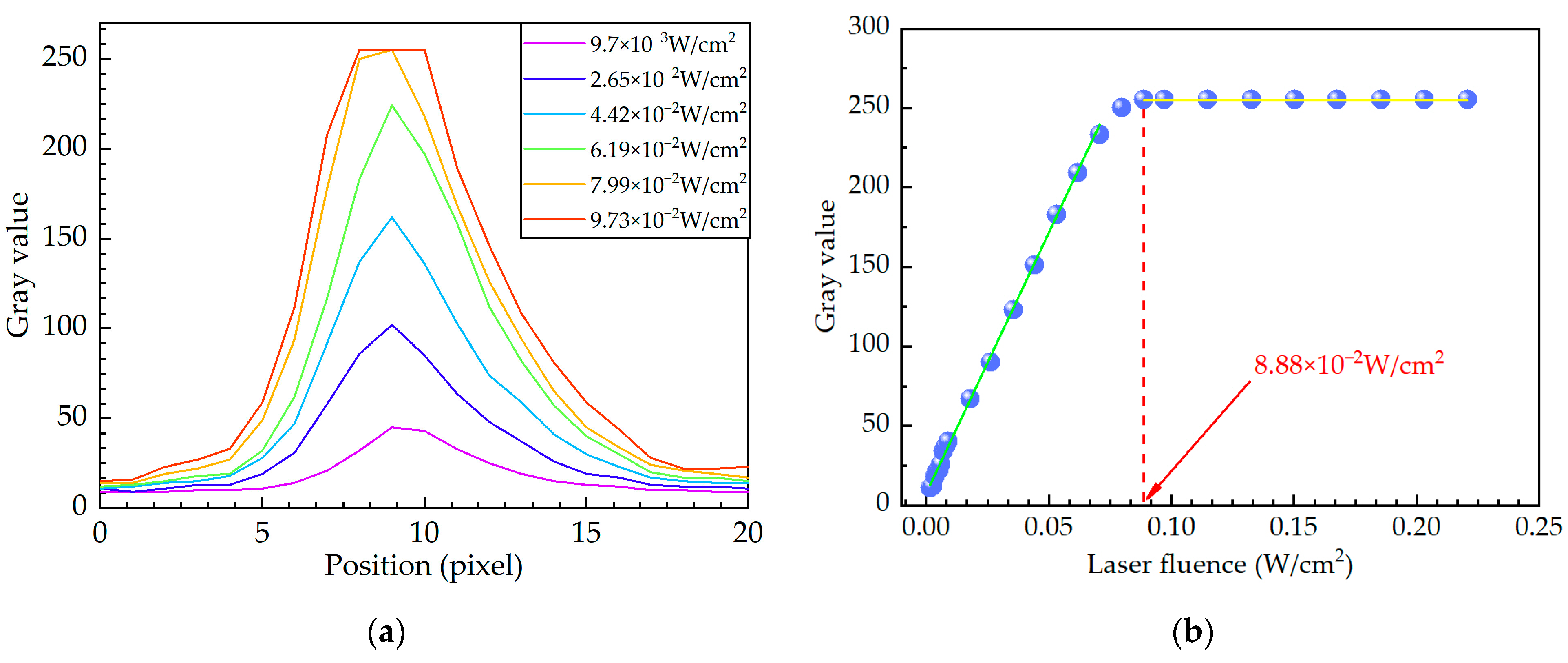
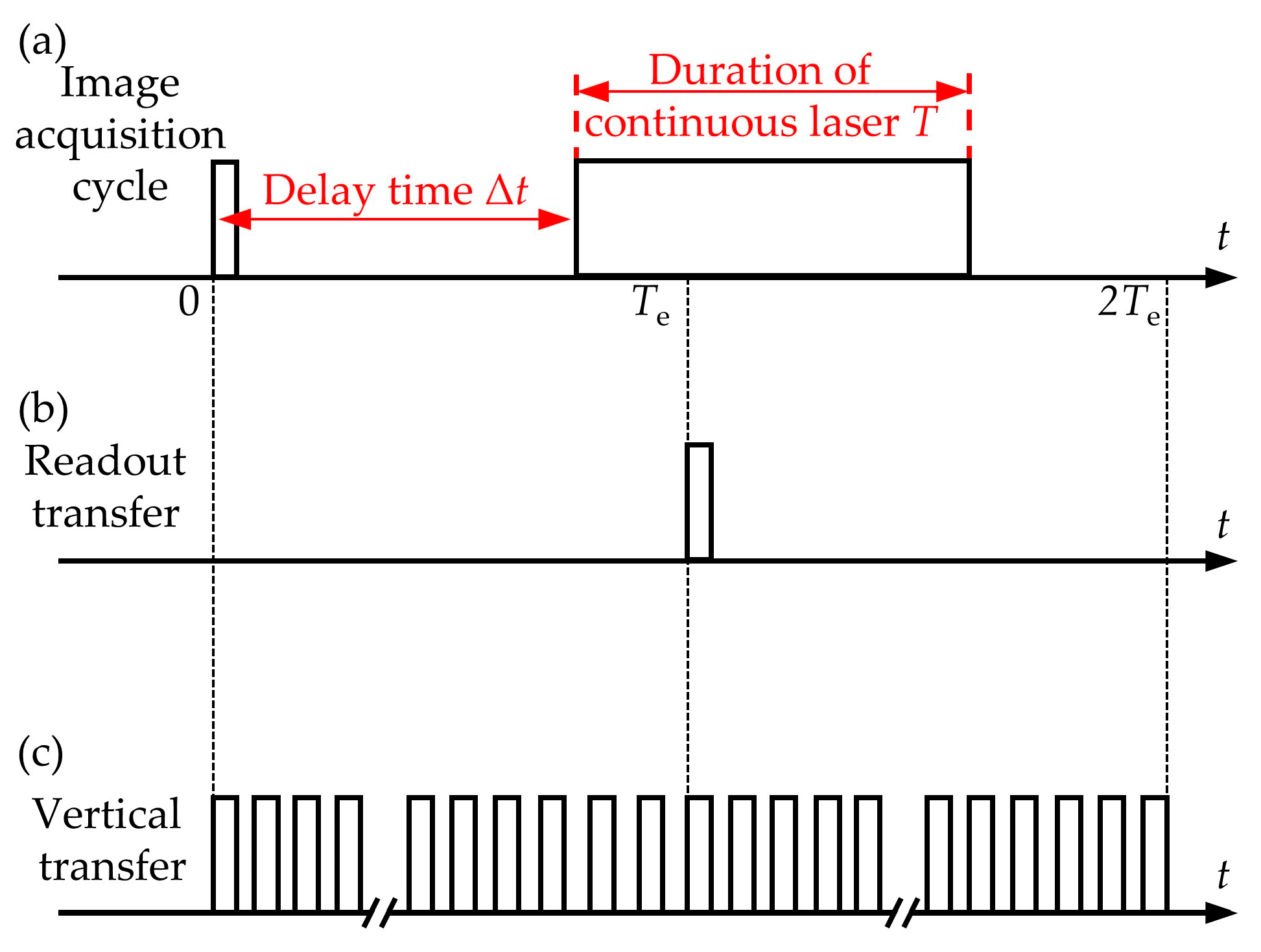
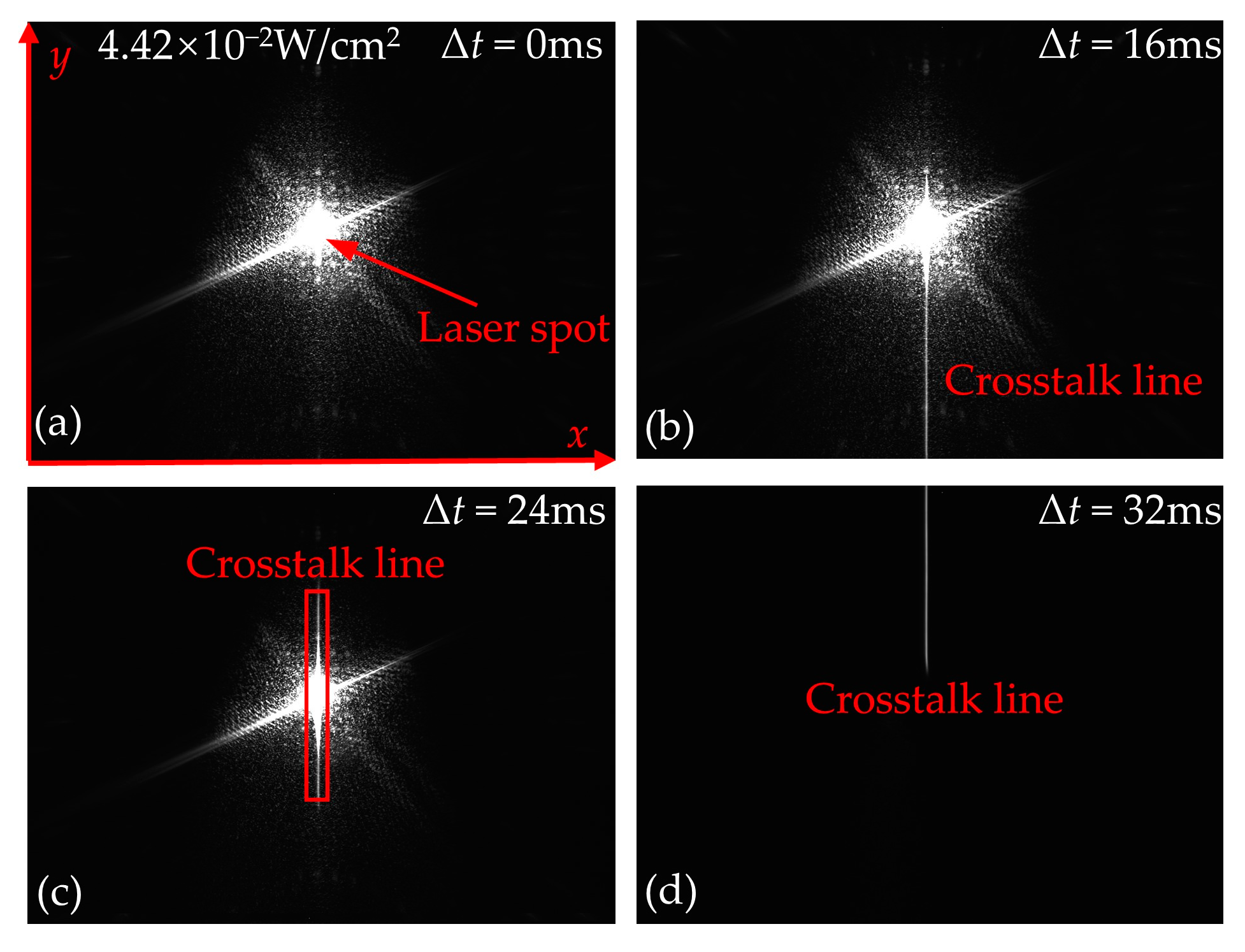
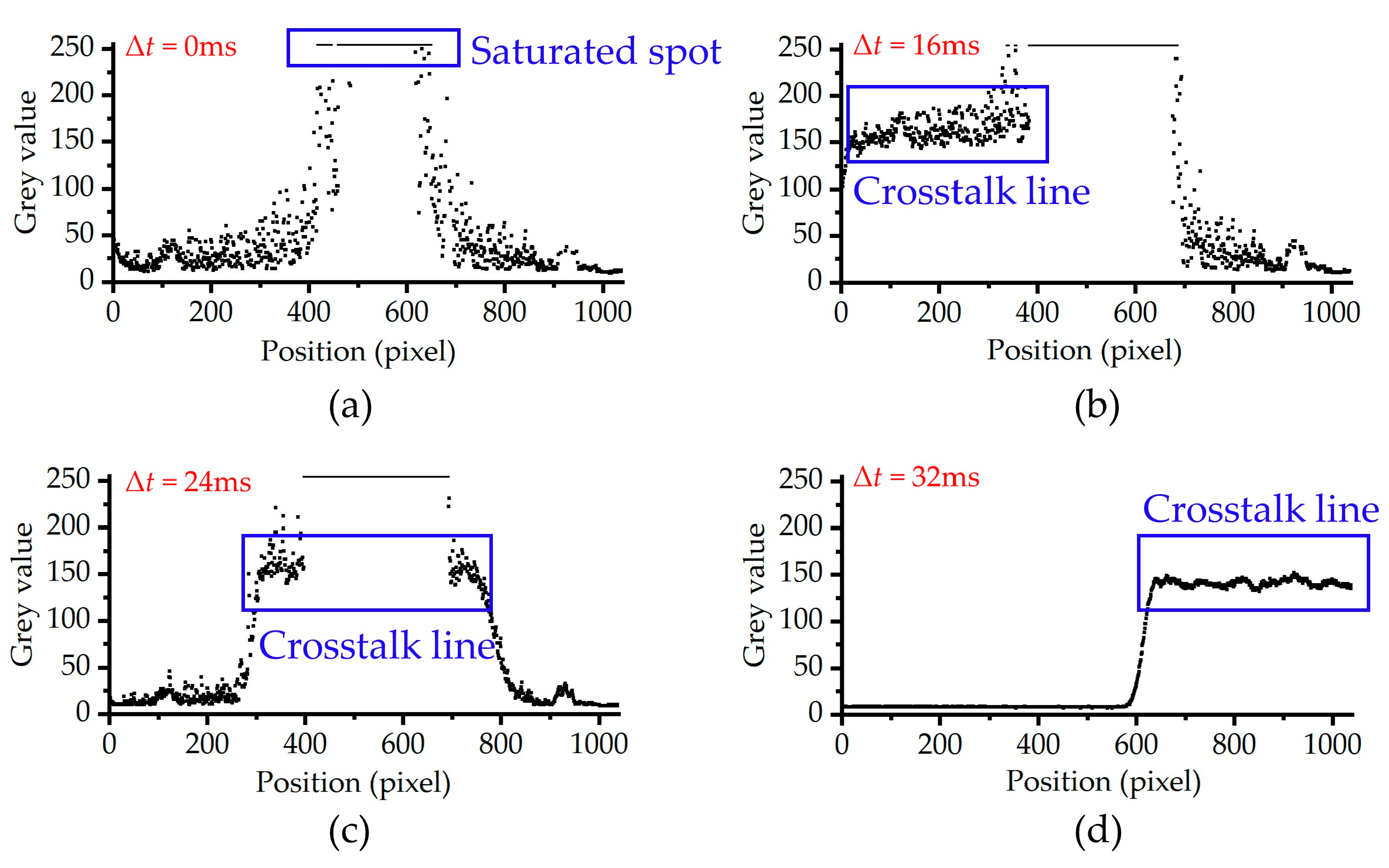

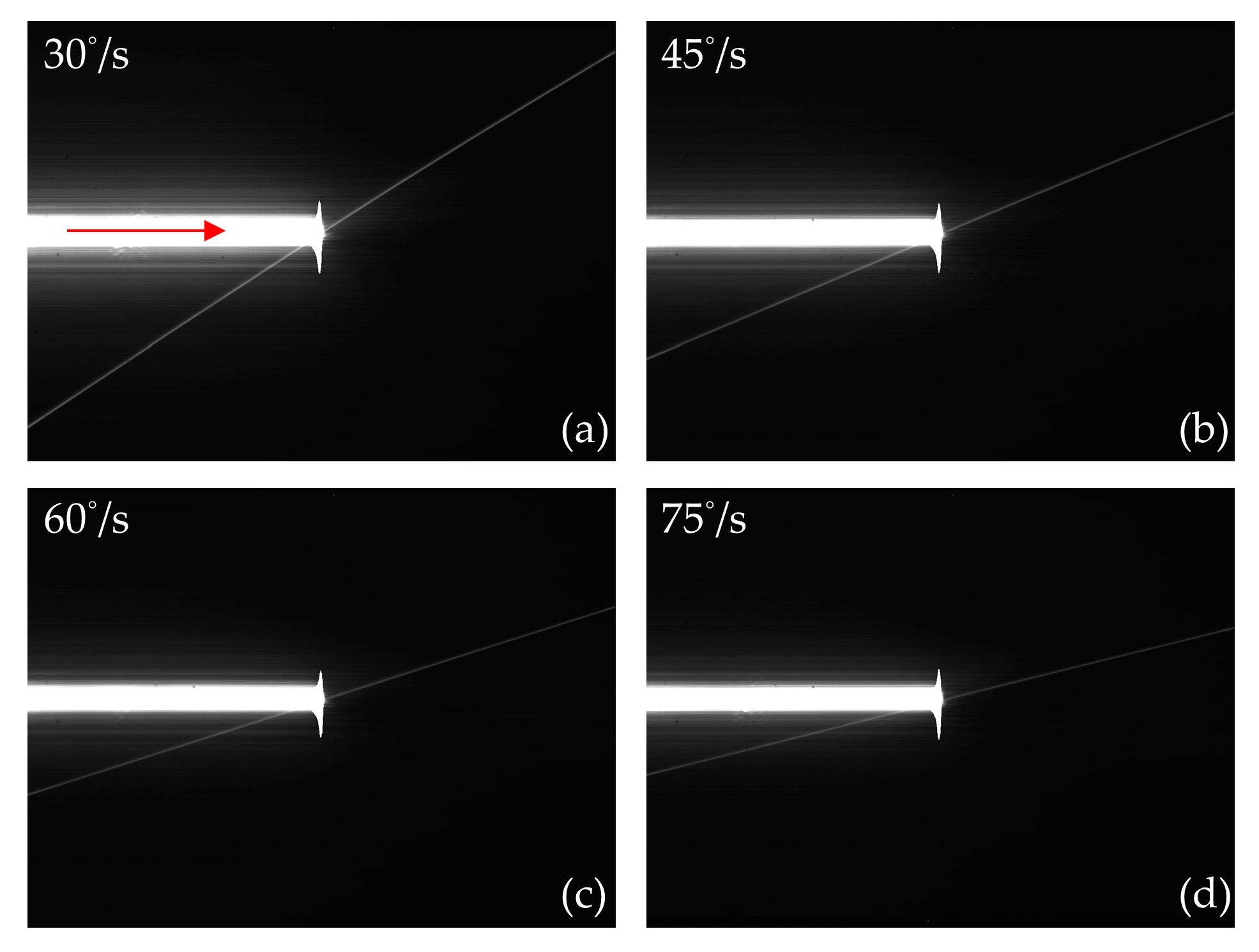
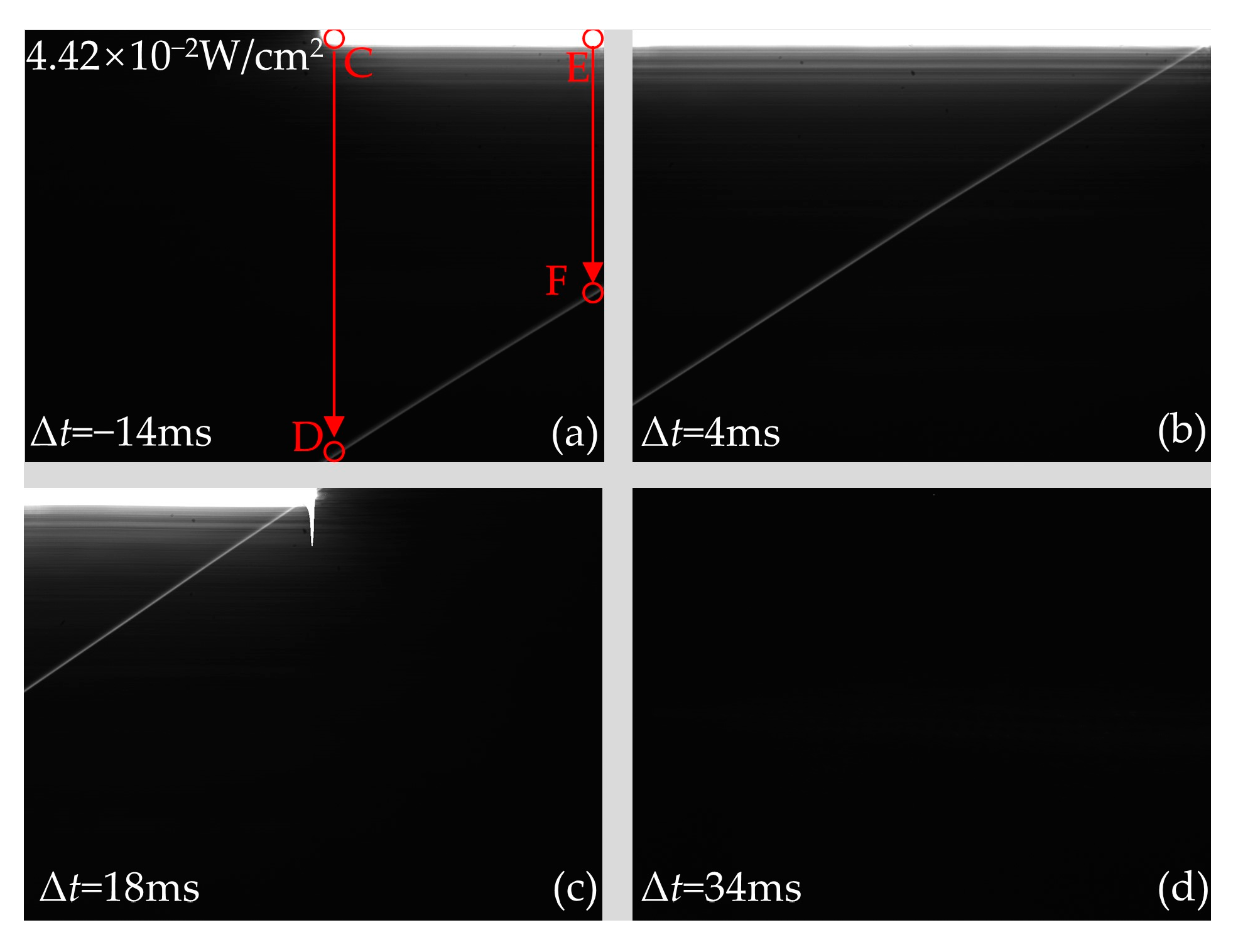
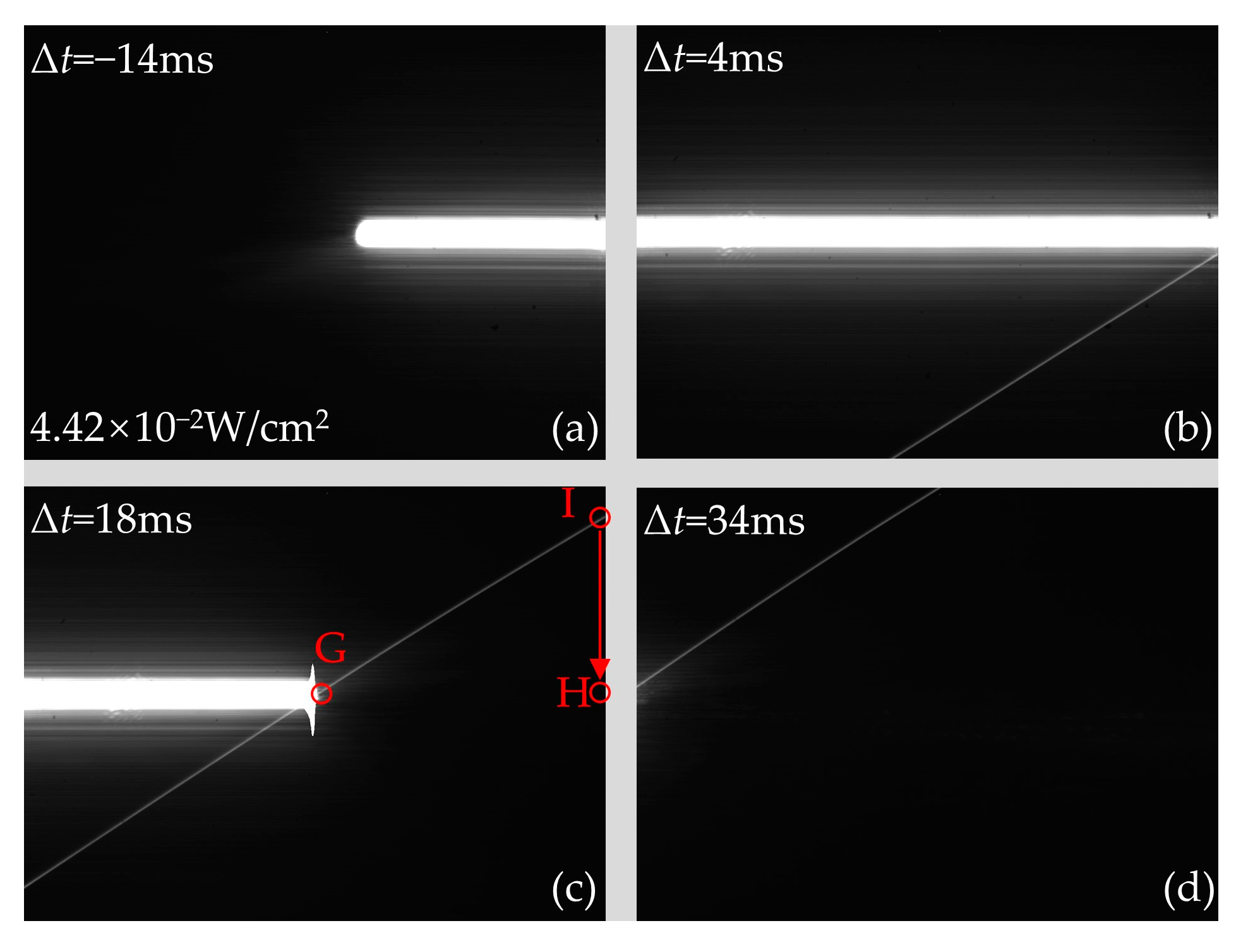


Disclaimer/Publisher’s Note: The statements, opinions and data contained in all publications are solely those of the individual author(s) and contributor(s) and not of MDPI and/or the editor(s). MDPI and/or the editor(s) disclaim responsibility for any injury to people or property resulting from any ideas, methods, instructions or products referred to in the content. |
© 2024 by the authors. Licensee MDPI, Basel, Switzerland. This article is an open access article distributed under the terms and conditions of the Creative Commons Attribution (CC BY) license (https://creativecommons.org/licenses/by/4.0/).
Share and Cite
Yu, C.; Ye, J.; Chang, H.; Li, N.; Guo, W. Temporal and Spatial Distribution Characteristics of Crosstalk Lines Generated by Irradiating Progressive Scan Charge-Coupled Device Camera with Continuous Laser. Sensors 2024, 24, 3966. https://doi.org/10.3390/s24123966
Yu C, Ye J, Chang H, Li N, Guo W. Temporal and Spatial Distribution Characteristics of Crosstalk Lines Generated by Irradiating Progressive Scan Charge-Coupled Device Camera with Continuous Laser. Sensors. 2024; 24(12):3966. https://doi.org/10.3390/s24123966
Chicago/Turabian StyleYu, Chenghao, Jifei Ye, Hao Chang, Nanlei Li, and Wei Guo. 2024. "Temporal and Spatial Distribution Characteristics of Crosstalk Lines Generated by Irradiating Progressive Scan Charge-Coupled Device Camera with Continuous Laser" Sensors 24, no. 12: 3966. https://doi.org/10.3390/s24123966




